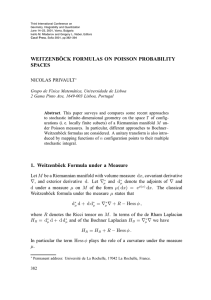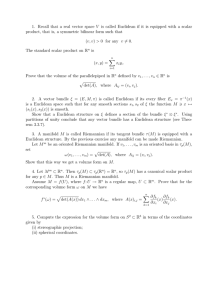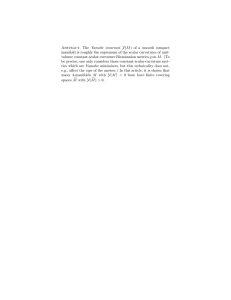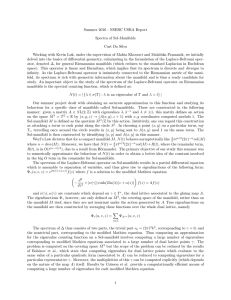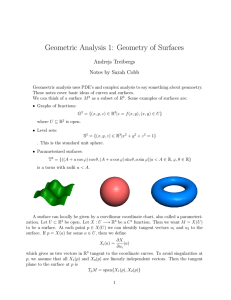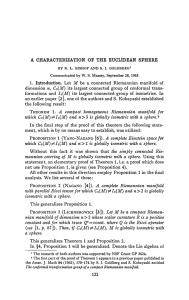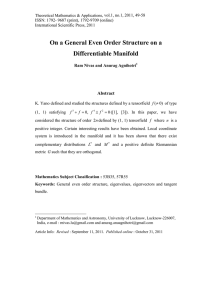A Degenerate Riemannian Manifold
advertisement
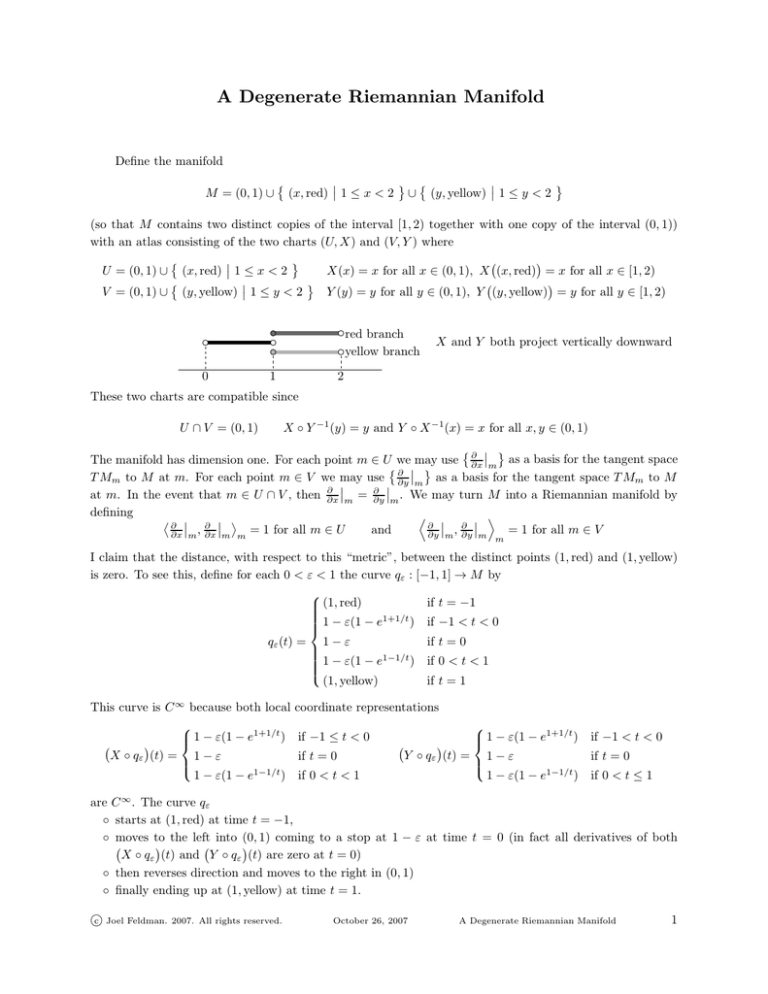
A Degenerate Riemannian Manifold Define the manifold M = (0, 1) ∪ (x, red) 1 ≤ x < 2 ∪ (y, yellow) 1 ≤ y < 2 (so that M contains two distinct copies of the interval [1, 2) together with one copy of the interval (0, 1)) with an atlas consisting of the two charts (U, X) and (V, Y ) where U = (0, 1) ∪ (x, red) 1 ≤ x < 2 X(x) = x for all x ∈ (0, 1), X (x, red) = x for all x ∈ [1, 2) V = (0, 1) ∪ (y, yellow) 1 ≤ y < 2 Y (y) = y for all y ∈ (0, 1), Y (y, yellow) = y for all y ∈ [1, 2) red branch yellow branch 0 1 X and Y both project vertically downward 2 These two charts are compatible since U ∩ V = (0, 1) X ◦ Y −1 (y) = y and Y ◦ X −1 (x) = x for all x, y ∈ (0, 1) ∂ as a basis for the tangent space The manifold has dimension one. For each point m ∈ U we may use ∂x m ∂ T Mm to M at m. For each point m ∈ V we may use ∂y m as a basis for the tangent space T Mm to M ∂ ∂ at m. In the event that m ∈ U ∩ V , then ∂x = ∂y . We may turn M into a Riemannian manifold by m m defining D E ∂ ∂ ∂ ∂ , , = 1 for all m ∈ U and = 1 for all m ∈ V ∂x m ∂x m m ∂y m ∂y m m I claim that the distance, with respect to this “metric”, between the distinct points (1, red) and (1, yellow) is zero. To see this, define for each 0 < ε < 1 the curve qε : [−1, 1] → M by (1, red) if t = −1 1+1/t ) if −1 < t < 0 1 − ε(1 − e if t = 0 qε (t) = 1 − ε 1−1/t 1 − ε(1 − e ) if 0 < t < 1 (1, yellow) if t = 1 This curve is C ∞ because both local 1+1/t ) 1 − ε(1 − e X ◦ qε (t) = 1 − ε 1 − ε(1 − e1−1/t ) coordinate representations if −1 ≤ t < 0 if t = 0 if 0 < t < 1 1+1/t ) if −1 < t < 0 1 − ε(1 − e Y ◦ qε (t) = 1 − ε if t = 0 1−1/t 1 − ε(1 − e ) if 0 < t ≤ 1 are C ∞ . The curve qε ◦ starts at (1, red) at time t = −1, ◦ moves to the left into (0, 1) coming to a stop at 1 − ε at time t = 0 (in fact all derivatives of both X ◦ qε (t) and Y ◦ qε (t) are zero at t = 0) ◦ then reverses direction and moves to the right in (0, 1) ◦ finally ending up at (1, yellow) at time t = 1. c Joel Feldman. 2007. All rights reserved. October 26, 2007 A Degenerate Riemannian Manifold 1 The “index shuffling” tangent vectors in the two coordinate patches are ε 1+1/t − t2 e X ◦ qε (t) = 0 ε 1−1/t t2 e d dt if −1 ≤ t < 0 d dt if t = 0 if 0 < t < 1 So the length of the curve qε is qε = Z 1 −1 Z q hqε∗t , qε∗t iq(t) dt = 0 −1 ε 1+1/t t2 e dt + Z 0 1 ε 1+1/t − t2 e Y ◦ qε (t) = 0 ε 1−1/t t2 e ε 1−1/t t2 e s= 1 dt =t Z if −1 < t < 0 if t = 0 if 0 < t ≤ 1 −∞ −1 εe1+s (−ds) + Z 1 εe1−s (−ds) ∞ −∞ 1 = ε − e1+s −1 + ε e1−s ∞ = 2ε By definition, the distance from (1, red) to (1, yellow) is the infimum of the lengths of all curves from (1, red) to (1, yellow). So this distance must be less than or equal to 2ε for all 0 < ε < 1. So the distance is exactly zero. This pathology is generally forbidden by appending to the definition of “manifold” the requirement that it be Hausdorff. This means that if x, y ∈ M with x 6= y, then there exist two open sets O and O′ in M with x ∈ O, y ∈ O′ and O ∩ O′ = ∅. c Joel Feldman. 2007. All rights reserved. October 26, 2007 A Degenerate Riemannian Manifold 2


